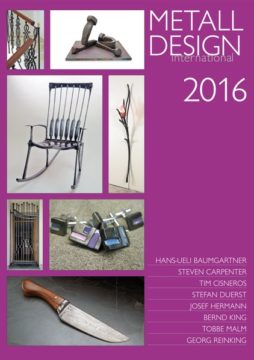Published by the editorial department of HEPHAISTOS, the international trade publication for metal designers, volume 18 of “MetalDesign International” once again illustrates how inexhaustible the possibilities of metal designers really are. From classic ironwork to modern architecture, from candle holder to bridge to garden pond, the diversity of the representatives is impressive. Illustrated in colour, the yearbook is enriched with informative texts on the biographies and works of the metal designers.
Among them is Bernd King, a down-to-earth man of action who has mastered traditional as well as classic metal design techniques. The “Blacksmith of Wangen” who was influenced by Stefan Neutz, Glynn Snellgrove and Wilhelm Häderle, sees himself not so much as an artist but more as an artisan. Next to implementation, he considers dealing with customers his strength and views this as a challenge.
Georg Reinking works in Italy. Upon discovering the beauty of iron, the German cabinetmaker jumped on his motorcycle and drove to Italy in order to work with Filippo Scioli – and found his calling. Today he works there in the region, honours the traditional forging techniques and applies them in contemporary metal design. Small series and unique, individually tailored pieces are created in his workshop.
Josef “Sepp” Hermann works in larger categories. He lives in Vorarlberg/Austria – where a modern building culture has been established in addition to maintaining old architecture. Hermann – ornamental metalworker, farrier, furniture and interior designer – knows how to take this trend into account without denying his roots. Many new houses bear his signature with their stairs, entrances, balcony railings and even façades.
Hans-Ueli Baumgartner’s grave markers can almost be called legendary. People from all cantons come to his home in Switzerland for them. His signature is clear, precise, contemporary – and quasi unmistakable. The large sculptures which have found their place in numerous exhibitions are in part fabricated in a forge under the direction of the experienced designer – who likes to push his limits.
Tim Cisneros is familiar with the highs and lows of a long life as a blacksmith. Although he did not complete a classic apprenticeship, the former farrier learned design over the years from other blacksmiths, during his travels, from books, the web and through trial and error. Joseph Habermann and Massimilliano Bottero spent time with him as journeymen, and many important pieces were created through interaction with colleagues.
Tobbe Malm born in Sweden and living in Norway became known to many as the organiser of the “Roses for Oslo” campaign. His works are based on experiences and encounters with people – they are intended to tell stories. There is a lot to tell since we was employed as a social worker before he discovered metalwork, making a name for himself in large part with his bolt sculptures.
Stefan Duerst on the other hand headed for training as a blacksmith directly. He was educated in creativity even as a child and began his apprenticeship as a metal designer after graduating from secondary school. With the emigration to Canada, a dream came true for the “child of Munich” influenced by Herbert Elflein and Julia Mangold. He has his own blacksmith shop in Godfrey where the Ontario landscape inspires his creativity.
Steven Carpenter, living and working in Norway, has a solid educational background – and not just as a blacksmith. He has studied graphic and ornamental design, art history and archaeology, and attended courses for special forging techniques. As an ambassador for his trade, he himself gives courses with up to four participants. He recently received an order from representatives of the Norwegian parliament.
- Veröffentlicht am Montag 7. Dezember 2015 von Hephaistos
- ISBN: 9783958050143
- 232 Seiten
- Genre: Design, Hardcover, Innenarchitektur, Kunst, Softcover
